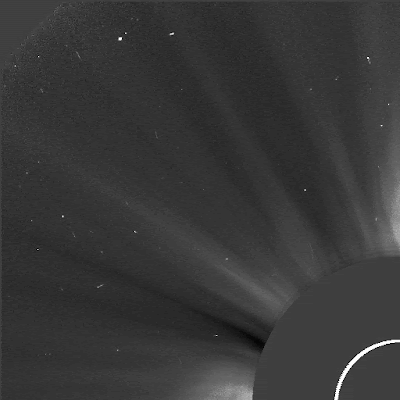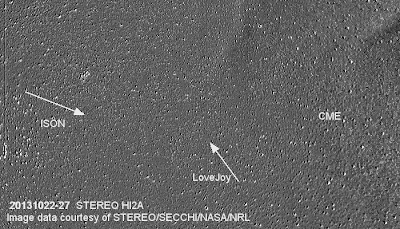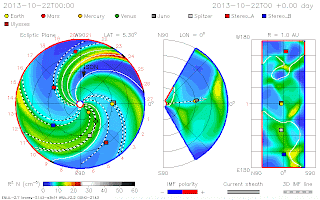Leaving the Sun
Comet ISON now a diffuse object leaving the harsh solar environment. Not much left ...
ISON in SOHO
A couple of views of ISON first fading in SOHO C3 and the new tail reappearing in SOHO C2.
Those with a keen eye will see the ISON gas tail swing away clock wise the C3 images and persist across the perihelion passage to continue to grow in C2
Ground Viewing 20131130
No luck as the comet was not condensed or bright enough, just dusticles and smudges. I could see some thermals when i pushed the pixels around with imageJ.
Update 20131130 ISON gets Hot!
You already know this and much more,but the data lag means we have to wait for the good images.
Update 20131129 - Well is was Fryday for ISON. It has been quite surprising, I'll post images when the good data is publicly available. But you may like to see these two long HI1A sequences.Here are my two avi's , may not load in windows viewer so use quicktime. Log scaled and contrast adjusted to make one pixel bright on ISON nucleus. Shows the tail material better.
STEREO HI1A ISON 20131120-24
A longer sequence 20131120-24
What dynamic features can you see? double click to make the video full screen, looks better..8)
A better long sequence 20131121-22
Logscaled images.
ISON Enters HI1A 20131120
more details become visible due to better imager resolution. Some rotational aspects become apparent, I think
ISON tail dynamics
more tails interactions in with the solar wind across 20131119 seen in STEREO HI2A
Make that four
A fourth small comet has appeared in the HI2A FOV. Comet Nevski..
Comet ISON has brightened and is interacting with passing CME material.
Three comets in the wind
ISOn, Lovejoy and now Encke are all detectable in STEREO HI2A images from 2013110
ISON showing some elongation. CME materials is passing by, long ION tails are being seen from ground images of all these comets. Encke is also in the FOV of STEREO HI1A showing some tail dynamics.
ISON in the solar wind
Comet ISON now a diffuse object leaving the harsh solar environment. Not much left ...
ISON in SOHO
A couple of views of ISON first fading in SOHO C3 and the new tail reappearing in SOHO C2.
Those with a keen eye will see the ISON gas tail swing away clock wise the C3 images and persist across the perihelion passage to continue to grow in C2
 |
| A new angle on ISON in SOHO C2 |
Ground Viewing 20131130
No luck as the comet was not condensed or bright enough, just dusticles and smudges. I could see some thermals when i pushed the pixels around with imageJ.
Update 20131130 ISON gets Hot!
You already know this and much more,but the data lag means we have to wait for the good images.
 |
| ISON brightness flares and Encke flys on.. |
Update 20131129 - Well is was Fryday for ISON. It has been quite surprising, I'll post images when the good data is publicly available. But you may like to see these two long HI1A sequences.Here are my two avi's , may not load in windows viewer so use quicktime. Log scaled and contrast adjusted to make one pixel bright on ISON nucleus. Shows the tail material better.
STEREO HI1A ISON 20131120-24
A longer sequence 20131120-24
What dynamic features can you see? double click to make the video full screen, looks better..8)
A better long sequence 20131121-22
Logscaled images.
ISON Enters HI1A 20131120
more details become visible due to better imager resolution. Some rotational aspects become apparent, I think
ISON tail dynamics
more tails interactions in with the solar wind across 20131119 seen in STEREO HI2A
 |
| ISON tail dynamics |
Make that four
A fourth small comet has appeared in the HI2A FOV. Comet Nevski..
Comet ISON has brightened and is interacting with passing CME material.
 |
| CME passing by ISON 20131114 |
 |
| ISON interacts with CME, tail disconnection event 20131114 |
Three comets in the wind
ISOn, Lovejoy and now Encke are all detectable in STEREO HI2A images from 2013110
ISON showing some elongation. CME materials is passing by, long ION tails are being seen from ground images of all these comets. Encke is also in the FOV of STEREO HI1A showing some tail dynamics.
ISON in the solar wind
Update 20131030-
ISON has been detected in STEREO HI1B roll data.
Recent images from the ground have seen some tail disturbances of LoveJoy. A CME plume is passing by, more are following.
I tweaked these images and data from the Goddard and STEREO NASA guys to show where ISON is in relation to the windy inner solar system. You can also see the new Lovejoy comet tracking northwards. The colorful charts shows CME predictions into the future, while the STEREO images are from the past 5 days.
ISON has been detected in STEREO HI1B roll data.
Recent images from the ground have seen some tail disturbances of LoveJoy. A CME plume is passing by, more are following.
I tweaked these images and data from the Goddard and STEREO NASA guys to show where ISON is in relation to the windy inner solar system. You can also see the new Lovejoy comet tracking northwards. The colorful charts shows CME predictions into the future, while the STEREO images are from the past 5 days.
ISON possibilities
This image of comets disrupting or vaporizing as seen from STEREO COR2 image data. Well known Lovejoy is the only one that made it around the corner before failing. A few Kreutz examples are here and a SWAN detected comet. I think there are different events happening in the images. SWAN appears to vapourize while the others appear to disrupt before getting close. These are possibilities for ISON as it get close to the SUN.
















































